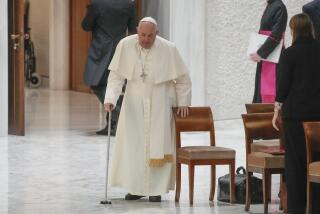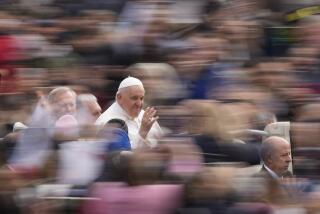Pope to Visit Holy Land in March
- Share via
VATICAN CITY — Pope John Paul II will make a millennium pilgrimage to the Holy Land in March--a visit that fulfills a long-held dream even as it thrusts the frail pontiff into the heart of Middle East political and religious tensions.
The Vatican is also pushing ahead on an even more politically fraught trip to Iraq. The United States, Britain and Iraqi dissidents have opposed the trip, fearing Saddam Hussein would use it for propaganda.
A Vatican advance team will go to Iraq on Saturday to lay plans for a possible papal pilgrimage in January to the Iraqi city of Ur, the Vatican missionary news service Fides said. Ur is the traditional birthplace of Abraham.
The pope’s visit to the Holy Land will take place in the last 10 days of March--a month before Easter--and will probably include stops in Jerusalem, Nazareth and Bethlehem, Archbishop Crescenzio Sepe said Wednesday at the Vatican.
Israel and Palestinian officials welcomed news of the visit, the first papal trip to the Holy Land since Pope Paul VI entered Jerusalem in 1964--before Israel took the whole of the city in the 1967 Six-Day War.
“We all hope that this visit is going to reinvigorate and support the spirit of peace and reconciliation between religions and the peoples of the Middle East,” said Effi Ben-Matityahu, an Israeli Foreign Ministry spokesman.
Israeli leaders “welcome this visit,” Prime Minister Ehud Barak said.
Still, even with the blessings of both sides, the pontiff will have to step carefully through the treacherous landscape of religious and political conflicts.
In Jerusalem, a holy city to Jews, Christians and Muslims, both Israelis and Palestinians will see the pope’s visit as legitimizing their claims of sovereignty.
Palestinians have long seen the Vatican as sympathetic to their claims to the city’s eastern sector--which they want as a capital for a future state. Last year, the Vatican’s secretary of state called Israeli rule there an illegal military occupation.
But many Israelis see John Paul’s agreement to visit the city now as a tacit recognition of Israel’s sovereignty.
The pope has made a mission of improving relations with Jews, and it was in his now 21-year-old papacy that Israel and the Vatican established diplomatic relations.
There will be no escaping the dispute: The Christian sites that the pontiff is most likely to visit--the Church of the Holy Sepulcher and the Mount of Olives--lie in East Jerusalem.
In Nazareth--city of Christ’s boyhood--John Paul walks into the thick of a feud between Christians and Muslims, who have been given permission to build a mosque next to a Christian shrine.
The Vatican issued unusually strong protests against Israel for granting the permission, warning it could lead the pope to drop the town from his itinerary.
Sepe, however, listed Nazareth among the likely papal stops, saying it could be timed to the March 25 feast of the Annunciation.
Nonetheless, the mosque dispute is unresolved. “Our objections still stand,” said a Vatican spokesman, the Rev. Ciro Benedettini.
Muslims in Nazareth plan to lay the cornerstone for the mosque on Tuesday, said Salman abu Ahmed, head of the Islamic Party in the city, who promised that when the pope comes, “we will make him a great party.”
“We welcome news of the pope’s arrival. It’s a good thing--it will promote good feelings among us all,” Ahmed said. “After all, it’s the pope. He’s not just anybody.”
The 79-year-old pontiff has made 89 pilgrimages outside Italy. His only other visit to the Middle East was to Lebanon.
In recent travels, John Paul has increasingly shown his ills, shuffling his feet and sometimes grimacing in pain. His hands tremble and his speech is slurred, and the Vatican no longer denies reports that he suffers from Parkinson’s disease, a progressive neurological disorder.
More to Read
Sign up for Essential California
The most important California stories and recommendations in your inbox every morning.
You may occasionally receive promotional content from the Los Angeles Times.










